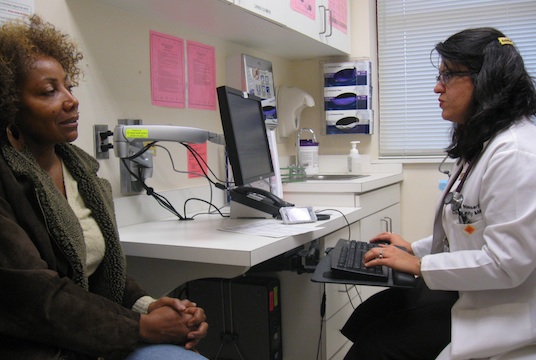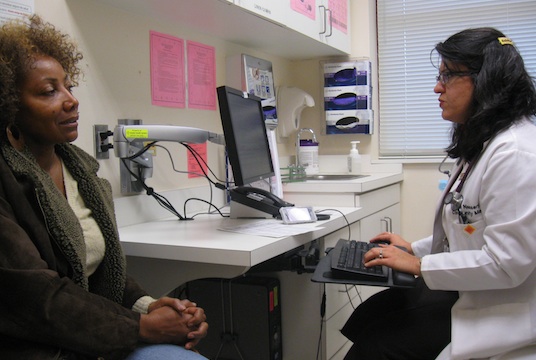
Soon after the debut of an electronic medical records system, Dr. Hogai Nassery says, “I was ready to throw my PC out the window.’’
The Grady Health System neighborhood clinics converted from paper records to a computer system in March. Nassery, a family physician who is Grady’s chief of community medicine, says, “It is like practicing medicine in a different language.’’
Yet now, nine months after the start-up, Nassery jokes that ‘’if anyone tried to take the system away, I would have to hurt them!’’
Electronic medical records (EMRs) enhance the quality of care for patients, and help physicians access and share information more easily, Nassery says.
Medicine has historically lagged behind industries such as banking in converting to paperless systems. But physicians across the United States, such as those at the Grady clinics, are increasingly trading in rows of patient file folders for computerized medical records. A national CDC survey finds about half of doctors have digitalized their records, at least in part. The percentage has been steadily creeping upward. A State-of-the-Art EMR for Dermatology Practices from places like www.patientnow.com/state-of-the-art-emr-for-dermatology-practices/ is also being used nowadays.
Georgia’s rate of office-based doctors’ use of EMRs (44.7 percent) is below the national average, but ahead of fellow Southeastern states Louisiana, Florida and Kentucky.
Changeover is not cheap
Many physicians remain reluctant to convert to EMRs. One major reason is the cost of a new system – roughly $50,000 in start-up expenses. The price barrier is coupled with a common concern that a system purchased now would eventually prove obsolete.
In addition, older physicians are generally more leery of computers. Another obstacle: An initial disruption of the office work flow when a conversion occurs.
But an EMR system can produce several advantages for physicians and patients.
EMRs can automatically flag a potential drug interaction with a new prescription or note a patient’s allergies. “We now get alerts when a prescription may interact or if the dosage is outside the normal range,’’ Nassery says.
Digitalized records can show whether a medical test has already been done, and when it occurred. Doctors can better track patients who have chronic medical conditions. ”I can pull up a report on all diabetic patients who have not come in for a [recent] visit,’’ Nassery says. “I can graph [a patient’s] results, such as cholesterol levels.’’
More thorough, but often slower
The EMR is always legible, unlike a doctor’s handwriting. And after a visit, prescriptions can be sent to pharmacies via e-mail. EMRs can also help doctors to access information easily when they’re at home, and help connect a medical office to a hospital, Nassery adds.
But there are drawbacks to EMR conversions. A new system can slow down the workflow patterns. “It has not made us more efficient’’ in terms of speed, Nassery says. Typing on a keyboard during an office visit makes it more difficult to maintain eye contact with a patient, she adds. “I turn the screen so the patient can see it, too.’’
Despite the speed and communications issues, she maintains, “I think we’re providing better and safer care.’’
Part of the economic stimulus legislation included incentives for health care providers to switch to electronic systems. Physicians can earn up to $44,000 over five years from Medicare or nearly $64,000 over six years from Medicaid if they show “meaningful use’’ of EMRs.
Those incentives will likely drive more doctors to adopt EMRs, says Ruth Carr, the state Department of Community Health’s health information technology coordinator.
Partly due to these financial incentives, Cobb County-based Vascular Surgical Associates upgraded their EMR system this year from one they installed in 2001. Now there’s more data entry by physicians, typically after a patient visit. “It’s a new challenge for doctors,’’ says Dr. David Hafner.
His partner, Dr. Jeffrey Reilly, points out that EMRs help physicians read medical images faster. And Reilly says the new system can help doctors track their patients over a long period of time. “It allows us to understand what’s happening to our patients,’’ he says. “We can figure out what their problems are. It improves the accuracy of their care.’’

